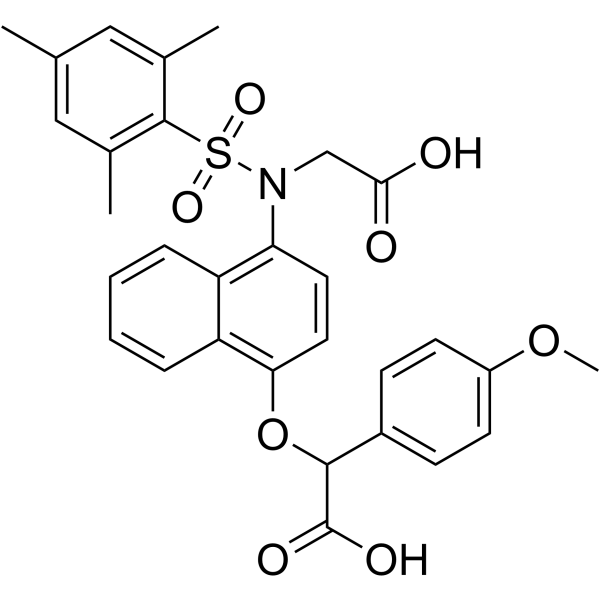Keap1-Nrf2-IN-14
Modify Date: 2024-01-27 10:51:36

Keap1-Nrf2-IN-14 structure
|
Common Name | Keap1-Nrf2-IN-14 | ||
|---|---|---|---|---|
| CAS Number | 1928782-31-3 | Molecular Weight | 563.62 | |
| Density | N/A | Boiling Point | N/A | |
| Molecular Formula | C30H29NO8S | Melting Point | N/A | |
| MSDS | N/A | Flash Point | N/A | |
Use of Keap1-Nrf2-IN-14Keap1-Nrf2-IN-14 (compound 20c) is a KEAP1-NRF2 inhibitor that effectively disrupts the KEAP1-NRF2 interaction (IC50=75 nM) with a Kd value of 24 nM for KEAP1. Keap1-Nrf2-IN-14 induces the expression of NRF2 target genes and enhances the downstream antioxidant and anti-inflammatory activities. Keap1-Nrf2-IN-14 can be used in the study of oxidative stress-related inflammation[1]. |
| Name | Keap1-Nrf2-IN-14 |
|---|
| Description | Keap1-Nrf2-IN-14 (compound 20c) is a KEAP1-NRF2 inhibitor that effectively disrupts the KEAP1-NRF2 interaction (IC50=75 nM) with a Kd value of 24 nM for KEAP1. Keap1-Nrf2-IN-14 induces the expression of NRF2 target genes and enhances the downstream antioxidant and anti-inflammatory activities. Keap1-Nrf2-IN-14 can be used in the study of oxidative stress-related inflammation[1]. |
|---|---|
| Related Catalog | |
| Target |
KEAP1-NRF2:75 nM (IC50) |
| In Vitro | Keap1-Nrf2-IN-14 effectively activated NRF2-ARE regulated cytoprotective defense system in both concentration- and time- dependent manner in RAW264.7 cells[1]. Keap1-Nrf2-IN-14 (1, 10 µM; 12 h) enhanced the antioxidant capacity in macrophage RAW 264.7 cells[1]. Keap1-Nrf2-IN-14 (1, 10 µM; 12 h) attenuates LPS-induced production of inflammation factors in RAW 264.7 cells[1]. Keap1-Nrf2-IN-14 shows high metabolic stability (in co-incubation with rat liver microsomes with half-life of 10.5 h), and have no CYP inhibition on 1A2, 2C9, 2C19, 2D6 and 3A4 when at 10 µM. Cell Viability Assay[1] Cell Line: RAW264.7 cells (LPS-stimulated) Concentration: 10 µM Incubation Time: 12 h Result: Significantly reduced ROS generation to nearly normal level. Cell Viability Assay[1] Cell Line: RAW264.7 cells (LPS-stimulated) Concentration: 1, 10 µM Incubation Time: 12 h Result: Notably restored the SOD and GSH-Px levels. Markedly attenuated the levels of the inflammatory factors IL-1b, IL-6, TNF-a and NO (induced by LPS) in a concentration-dependent manner, and when at 10 µM, almost reduced these cytokines to the basal level. RT-PCR[1] Cell Line: RAW264.7 cells Concentration: 0.1, 1, 5, 10 µM Incubation Time: 12 h Result: Strongly increased the transcription of NRF2 regulated genes in RAW264.7 cells at a concentration-dependent manner. Western Blot Analysis[1] Cell Line: RAW264.7 cells Concentration: 10 µM Incubation Time: 1, 2, 4, 8, 16, 24 h Result: Led to nuclear translocation of NRF2 began within 2 h, maximized at 8 h and subsequently declined after 16 h. Induced NRF2, HO-1, NQO-1 and GCLM protein expression in a time- dependent manner. |
| In Vivo | Keap1-Nrf2-IN-14 (10 mg/kg; i.p.; single daily for 3 days) reduces the LPS-induced production of the proinflammatory factors in vivo[1]. Keap1-Nrf2-IN-14 (1 mg/kg; i.v.; single) shows half-life of 1.72 h in vivo[1]. Animal Model: Female C57BL/6 mice (18-22 g; LPS-induced inflammation model)[1]. Dosage: 10 mg/kg Administration: Intraperitoneal injection; single daily for 3 days. Result: Diminished LPS-induced inflammatory response in vivo. Animal Model: Female C57BL/6 mice (18-22 g; LPS-induced inflammation model)[1]. Dosage: 1 mg/kg Administration: Intravenous injection; single. Result: Led to half-life of 1.72 h. |
| References |
| Molecular Formula | C30H29NO8S |
|---|---|
| Molecular Weight | 563.62 |